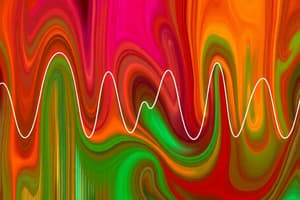Podcast
Questions and Answers
Explain the significance of Jesus entrusting Mary to John while on the cross.
Explain the significance of Jesus entrusting Mary to John while on the cross.
Jesus was giving Mary to us as our mother, too.
What does it mean that Jesus's willingess to suffer and die tells us about God?
What does it mean that Jesus's willingess to suffer and die tells us about God?
Jesus loves us to death. Jesus made up for our sins.
Describe the scene at Calvary when Jesus was crucified. Include key details from the text.
Describe the scene at Calvary when Jesus was crucified. Include key details from the text.
Roman soldiers nailed Jesus to the cross between two thieves. Soldiers gambled for his clothes. People mocked him. Mary and the apostle John watched.
What crime was posted above Jesus' head?
What crime was posted above Jesus' head?
How has the cross become the symbol for Christianity?
How has the cross become the symbol for Christianity?
What did Jesus sacrifice to save us?
What did Jesus sacrifice to save us?
Explain the connection between sin and our friendship with God.
Explain the connection between sin and our friendship with God.
Why is Jesus referred to as the Lamb of God?
Why is Jesus referred to as the Lamb of God?
According to the old testament(cf. Num 21:1-9), how were people rescued from death?
According to the old testament(cf. Num 21:1-9), how were people rescued from death?
How did people treat Jesus the night before his death?
How did people treat Jesus the night before his death?
What is the Triduum, and what does it celebrate?
What is the Triduum, and what does it celebrate?
How does the text connect the freeing of slaves with Jesus's sacrifice?
How does the text connect the freeing of slaves with Jesus's sacrifice?
Discuss Saint John's role among the Apostles, highlighting unique aspects described in the text.
Discuss Saint John's role among the Apostles, highlighting unique aspects described in the text.
How do Christians connect the bronze serpent to the crucifixion of Jesus?
How do Christians connect the bronze serpent to the crucifixion of Jesus?
How did the apostle Judas betray Jesus?
How did the apostle Judas betray Jesus?
What is the Stations of the Cross?
What is the Stations of the Cross?
How is the symbol of the bronze serpent related to modern medicine?
How is the symbol of the bronze serpent related to modern medicine?
What is a New Covenant?
What is a New Covenant?
Where did Jesus go with the apostles after the last supper?
Where did Jesus go with the apostles after the last supper?
Besides Jesus who else was crucified?
Besides Jesus who else was crucified?
Flashcards
Death of Jesus
Death of Jesus
Roman soldiers nailed Jesus' hands and feet to the cross on Calvary, between two crucified thieves.
Suffering of Jesus
Suffering of Jesus
Jesus asked the apostles to pray, but they were sleeping. Judas kissed Jesus, and soldiers captured him.
New Covenant
New Covenant
Jesus offered himself to the Father for us, establishing a New Covenant at the Last Supper.
Stations of the Cross
Stations of the Cross
Signup and view all the flashcards
Triduum
Triduum
Signup and view all the flashcards
Bronze Serpent
Bronze Serpent
Signup and view all the flashcards
The Lamb of God
The Lamb of God
Signup and view all the flashcards
John the Apostle
John the Apostle
Signup and view all the flashcards
Why did Jesus Die?
Why did Jesus Die?
Signup and view all the flashcards
Study Notes
The Laplace Transform
- Transforms a function f(t), defined for t ≥ 0, into a function F(s).
- F(s) = ∫₀^∞ e⁻ˢᵗ f(t) dt, where s is a complex frequency parameter (s = σ + jω).
Region of Convergence (ROC)
- Laplace transform exists when the integral converges.
- Convergence occurs when Re(s) > a for some real number a.
- ROC is defined as Re(s) > a.
Properties of Laplace Transforms
- Linearity: The transform of a linear combination is the linear combination of the transforms such that L{af(t) + bg(t)} = aL{f(t)} + bL{g(t)}.
- Time Scaling: L{f(at)} = (1/|a|)F(s/a).
- Time Shifting: L{f(t - a)u(t - a)} = e⁻ᵃˢF(s), where u(t) is the Heaviside step function.
- Shifting in the s-Domain: L{eᵃᵗf(t)} = F(s - a).
- Differentiation in the Time Domain: L{d/dt f(t)} = sF(s) - f(0).
- Differentiation in the Time Domain: L{d²/dt² f(t)} = s²F(s) - sf(0) - f'(0).
- Differentiation in the Time Domain: L{dⁿ/dtⁿ f(t)} = sⁿF(s) - sⁿ⁻¹f(0) - sⁿ⁻²f'(0) -... - f⁽ⁿ⁻¹⁾(0).
- Integration in the Time Domain: L{∫₀ᵗ f(τ) dτ} = F(s)/s.
- Differentiation in the s-Domain: L{tf(t)} = -d/ds F(s).
- Differentiation in the s-Domain: L{tⁿf(t)} = (-1)ⁿ dⁿ/dsⁿ F(s).
- Convolution: L{(f * g)(t)} = F(s)G(s), where (f * g)(t) = ∫₀ᵗ f(τ)g(t - τ) dτ.
- Initial Value Theorem: lim t→₀ f(t) = lim s→∞ sF(s).
- Final Value Theorem: lim t→∞ f(t) = lim s→₀ sF(s).
Common Laplace Transforms
- Unit Impulse: f(t) = δ(t), F(s) = 1, ROC: All s.
- Unit Step: f(t) = u(t), F(s) = 1/s, ROC: Re(s) > 0.
- Ramp: f(t) = t, F(s) = 1/s², ROC: Re(s) > 0.
- Exponential: f(t) = eᵃᵗ, F(s) = 1/(s - a), ROC: Re(s) > Re(a).
- Sine: f(t) = sin(ωt), F(s) = ω/(s² + ω²), ROC: Re(s) > 0.
- Cosine: f(t) = cos(ωt), F(s) = s/(s² + ω²), ROC: Re(s) > 0.
- Hyperbolic Sine: f(t) = sinh(at), F(s) = a/(s² - a²), ROC: Re(s) > |a|.
- Hyperbolic Cosine: f(t) = cosh(at), F(s) = s/(s² - a²), ROC: Re(s) > |a|.
- Damped Sine: f(t) = e⁻ᵃᵗsin(ωt), F(s) = ω/((s + a)² + ω²), ROC: Re(s) > -a.
- Damped Cosine: f(t) = e⁻ᵃᵗcos(ωt), F(s) = (s + a)/((s + a)² + ω²), ROC: Re(s) > -a.
- t to the power of n: f(t) = tⁿ, F(s) = n!/sⁿ⁺¹, ROC: Re(s) > 0.
Vectors
- Vectors are fundamental in physics.
Sum of Vectors
Graphical Method
- Vectors A and B are placed sequentially, maintaining their magnitude, direction, and sense.
- The resultant vector R connects the origin of the first vector to the end of the last vector.
Analytical Method
- Rectangular components of a vector:
- Aₓ = A cos θ.
- A
y = A sin θ.
- Sum of vectors using components:
- Rₓ = Aₓ + Bₓ + ...
- R
y = Ay + By + ... - R = √(Rₓ² + *R
y*²). - θ = arctan(R
y /Rₓ).
Product of Vectors
Scalar Product (Dot Product)
- Formula: A · B = AB cos θ = AₓBₓ + A
yB + Ay zB .z - The result is a scalar value.
Vector Product (Cross Product)
- Formula: A × B = AB sin θ n̂.
- Cross product represented as a determinant: result = (A
yB - Az zB )î + (Ay zBₓ - AₓBz )ĵ + (AₓBy - AyBₓ )k̂. - Result is a vector perpendicular to the plane formed by A and B.
- Direction determined by the right-hand rule.
Energy Bands and Charge Carriers in Semiconductors
Energy Bands
E vs. k Diagram
- Solutions to Schrödinger's equation for an electron in a crystal lattice can be expressed in this diagram.
Metals
- Fermi level lies within an allowed band, causing it to be partially filled.
Semiconductors
- The Fermi level is within the band gap, separating the filled valence band and the empty conduction band.
Insulators
- The Fermi level lies within a band gap, much larger than that of semiconductors.
Intrinsic Semiconductor
Definition
- A perfect crystal structure without impurities or lattice defects.
Materials
- Silicon (Si) and Germanium (Ge) are Group IV elements.
- Each atom is bonded covalently with four neighbors in a diamond crystal structure.
Energy Band Diagram at T = 0K
- All valence band states are full, and all conduction band states are empty.
Intrinsic Carrier Concentration (T > 0K)
- Thermally excited electrons jump from valence to conduction band, forming electron-hole pairs.
- n = p = n
i , where ni is the intrinsic carrier concentration.
Temperature Dependence
- The intrinsic carrier concentration (n
i ) increases exponentially with temperature.
Fermi Level
- In an intrinsic semiconductor, the Fermi level (E
F ) lies near the middle of the band gap (Eg ).
Intrinsic Carrier Concentration - Expression
- n
i = √(NcN ) e^(-Ev g /2kT).- N
c is the effective density of states in the conduction band. - N
v is the effective density of states in the valence band. - E
g is the band gap energy. - k is Boltzmann's constant.
- T is in Kelvin.
- N
Extrinsic Semiconductor
Doping
- Intentional addition of impurities to control electrical properties.
n-type Semiconductor
- Doped with donor impurities (e.g., Phosphorus in Silicon).
- Donors contribute electrons, increasing electron concentration (n > n
i ). - E
F moves closer to Ec .
p-type Semiconductor
- Doped with acceptor impurities (e.g., Boron in Silicon).
- Acceptors create holes, increasing hole concentration (p > n
i ). - E
F moves closer to Ev .
Compensation
- Occurs when both donor and acceptor impurities are present.
- Determined by impurity concentration to define conductivity type.
Carrier Transport Phenomena
Drift
- Charge carrier movement due to an electric field.
- J
drift = σE = q(nμn + pμp )E.- σ is the conductivity.
- E is the electric field.
- q is the elementary charge.
- n and p are electron and hole concentrations.
- μ
n and μp are electron and hole mobilities.
Diffusion
- Movement from high to low concentration.
- J
diffusion = qDn dn/dx - qDp dp/dx.- D
n and Dp are electron and hole diffusion coefficients. - dn/dx and dp/dx are the electron and hole concentration gradients.
- D
Einstein Relation
- Relates diffusion coefficient and mobility.
- D
n / μn = Dp / μp = kT/ q. - k is Boltzmann's constant.
- T is temperature in Kelvin.
- q is the elementary charge.
- D
Algorithmic Complexity
Definition and Purpose
- Quantification the amount of resources, such as time or memory needed by an algorithm.
- Enables the comparison of efficiencies between different algorithms that solve the same problem.
- Prediction of how well an algorithm will scale with increasing input size is possible.
Reasons to study algorithmic complexity
- Aiding decision making regarding which algorithm best fits the situation.
- Enhancing code performance by optimization.
- Develop an understanding of computation limitations.
Methodology for assessing complexity
- Modeling the computation performed.
- Defining the input size "n".
- Counting operations as "n" changes.
- Expressing complexity using Big-O notation.
Models of Computation
- Turing Machine: Symbols manipulated on tape using rules table.
- Random Access Machine (RAM): Random access to memory.
- Word RAM: RAM with fixed size memory words.
- Real RAM: RAM that stores real numbers internally.
Big-O Notation
Definition
- "f(n) = O(g(n))" means there are constants c > 0 and n₀ > 0 where f(n) ≤ cg(n) for all n ≥ n₀.
Intuition
- "f(n)" grows no faster than "g(n)" as "n" approaches infinity.
Examples
- n² + n = O(n²*)*.
- 100n = O(n).
- log(n) = O(n).
Common complexities
| Name | Notation | Examples |
|---|---|---|
| Constant | O(1) | Accessing array elements |
| Logarithmic | O(log n) | Binary search |
| Linear | O(n) | Looping through arrays |
| Log-Linear | O(n log n) | Merge sort |
| Quadratic | O(n²) | Nested loops |
| Cubic | O(n³) | Matrix multiplications |
| Exponential | O(2ⁿ) | Traveling salesman (naive) |
Simplifying Big-O expressions
- Drop lower order terms: n² + n becomes n².
- Ignore constant factors, 100n becomes n.
- Always use the simplest expression: O(n² + n) becomes O(n²).
- Logarithms to different bases are equivalent, O(logₐ n) = O(log
b n) .
Common Searching algorithm complexities
- Linear Search: O(n).
- Binary Search: O(log n).
Common Sorting algorithm complexities
- Bubble Sort: O(n²).
- Merge Sort: O(n log n).
Caveats
- Deals with the asymptotic behavior of algorithms.
- Ignores constant factors, which still matters in practice.
- Gives no information about actual run times.
- Differentiates between "worst" against "average" case run times.
Algorithmic Game Theory
- Game theory studies mathematical models of strategic interaction among rational agents playing games.
- It is applied across social science, logic, system science and computer science.
Cooperative game theory
- Focuses on groups of players forming coalitions.
Non-cooperative game theory
- Focuses on individual players and their strategies.
Normal-Form Games
- Games described through payoff matrices.
Definition
A normal-form game is defined by the tuple (N, A, u) where:
- N is the number of n players.
- A is the finite set of actions available to all players with "a" being action profiles.
- u specifies expected payoff (utility) within strategy profiles to individual agents in money or equivalent value.
Illustrative Game: Prisoner's Dilemma
- Scenario is two suspects arrested lacking sufficient evidence, suspects encouraged toward betrayal of each other, but offered limited incentive.
Prisoner's Dilemma representation
- N = {1, 2}.
- A ᵢ = {Cooperate, Defect}, for i ∈ N.
Prisoner's Dilemma payoff matrix
| Cooperate | Defect |
- --------------|-----------|-----------|
- *Cooperate** | -1, -1 | -3, 0 |
- *Defect** | 0, -3 | -2, -2 |
Strategies
Pure Strategy
- Taking action "a
i " from "Ai ".
Mixed Strategy
- Probability distribution across "A
i ". - S
i denotes set of all possible mixed strategies. - For s
i in Si , let si (ai) be the probability of playing action a i in Ai with strategy si
Strategy Profiles
- A tuple s = {s₁, … s
n } where each player "i" selects mixed strategy in set "Si ". - Let S = S₁ × … × S
n denote the set of all strategy profiles.
Expected Utility
- Utility of player "i" under strategy profile "s": u
i (s) = ∑(a in A) ui (a) ∏(j in N) sj (aj).
Nash Equilibrium
Definition
- The best strategy for a single player depends on what strategies other players are using.
- Profile s* is NE if, for all players i in N and all s ᵢ in Sᵢ, uᵢ(sᵢ*, s*-ᵢ*) >= uᵢ(sᵢ, s*-ᵢ), where s*-ᵢ are strategies apart from i.
Interpretation
- Given others' strategies, no one gains by unilaterally changing strategy.
Example within Prisoner's Dilemma
- Only NE is (Defect, Defect).
Theoretical Underpinning
- Every normal-game model with a finite number of players/actions has NE(s) in its mixed strategizing.
Studying That Suits You
Use AI to generate personalized quizzes and flashcards to suit your learning preferences.




